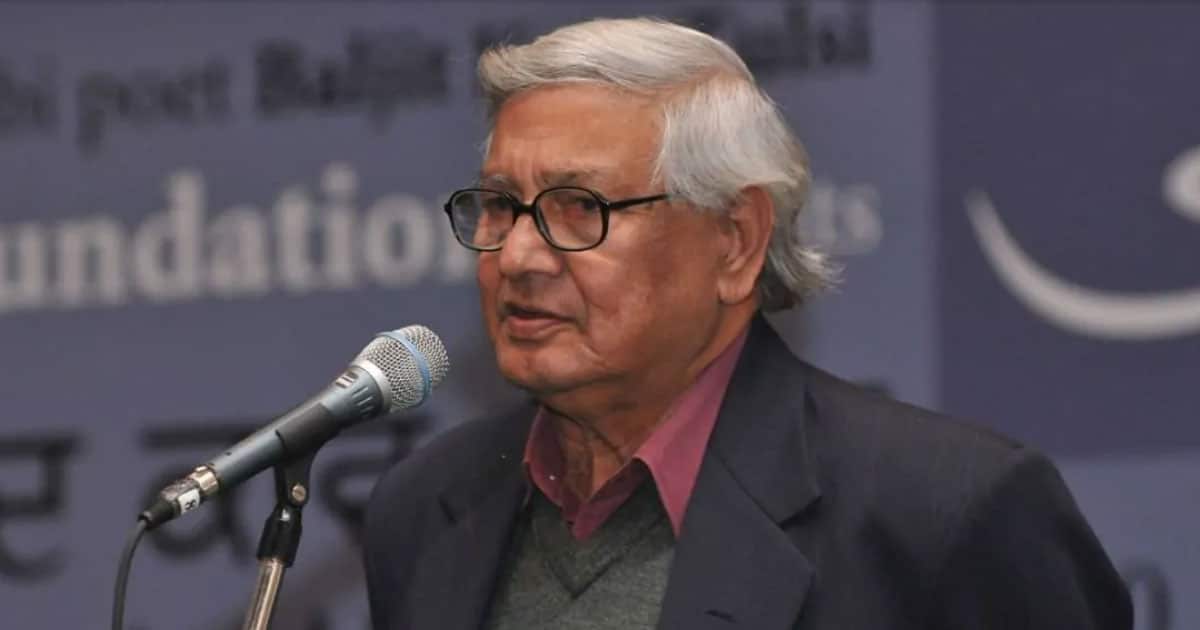ik sirf hamīñ mai ko ā.ankhoñ se pilāte haiñ
kahne ko to duniyā meñ mai-ḳhāne hazāroñ haiñ
– Shahryaar –
An innocent lie spoken by Kunwar Akhlaq Mohammad Khan to his father resulted in losing a prestigious job in the police department. However, it came as a blessing in disguise for the connoisseurs of poetry and masses.
Kunwar, later known as Shahryar, though both are synonyms, meaning prince was a true prince of Urdu poetry. Shahryar’s ghazals from Muzaffar Ali’s Umrao Jaan remain classics. Nearly nine years after his death, Shahryar has the distinction of receiving the highest award in literature, the Bhartiya Gyan Peeth award.

Early Life
Shahryar was born on 16 June 1936 in Aonla, a small town in the Bareilly district of Uttar Pradesh. Professor Mohammad Asim Siddiqui, the author of the monograph Shahryar, published by Sahitya Academy, narrates an interesting anecdote.
Shahryar had the offer of a job in the police department. His father was already a police officer, and so were his other ancestors. It happened such that Shahryar’s great grandfather saved the life of an Englishman during the revolt of 1857. In return, the Englishman got an order passed that all boys in Khan’s family, desirous of job in the police department, will be directly appointed as Thana-in-charge. The same applied to Shahryar, but he did not submit the form and lied to his father. Thus he was saved from serving in the police department and became a renowned Urdu poet.
In 1948, Shahryar moved to Aligarh with his family. There, he took admission into the Aligarh Muslim University. In 1955, he published his first ghazal in the magazine Mashrib, Karachi, and that was the beginning of his journey as an Urdu poet. An illustrious journey spanning over four decades.
Later, Shahryar also joined AMU as a Lecturer in 1966 and a Professor in 1987 before finally retiring in 1996.
As a lyricist in films, he had a brief but very successful stint. It started in 1978 with the film Gaman followed by Umrao Jaan in 1981 that became a rage. The music and ghazal lovers still can’t get away from humming Shahryar’s compositions. The Mujras picturized on actress Rekha in Umrao Jaan still has no match. But there is more to it.
Shahryar did not write especially for these films. His first collection of poems Ism-e-Azam came out in 1965. It included the famous ghazals “Seene Mei Jalan Aaankhon mei toofan sa kyun hai” (Gaman) and the first lines of ghazal “Ye Kya Jagah hai dosto, ye kaun sa dayaar hai” were part of a ghazal published in 1965. That means Shahryar wrote them nearly a decade ago, even before they became part of the films. These ghazals were so famous that later when the film director unsuccessfully contested from Lucknow parliamentary seat, he got these lines inscribed on his posters.
Professor Asim Siddiqui mentions that Shahryar also wrote for Yash Chopra’s movie Faasle and a couple of other films that were not released. In Aligarh, there is a story that Yash Chopra wanted to sign Shahryar for three more films, but he did not accept the offer as he relished working at his own pace.
Shahryar’s Poetry
With his first collection of poems, Ism-e-Azam, which had 62 nazm and 26 ghazals, it was a foregone conclusion that a new signature has arrived in literary circles. With his other collection Saatvan Dar (1969), Shahryar sealed his authority in Urdu poetry.
Professor Siddiqui mentions that Shahryar was a man of friends. He penned poems that were dedicated to his family and friends. These poems and couplets reflected his love, remorse, and sadness for the situations which his family and friends faced.
To cite an example, for his friend Iqbal Siddiqui after they got busy in their life and meeting became a rarity, Shahryar wrote, “Tum ko bhula dene ki koshish, Maine ki aur haar gaya (I tried to forget you, and I lost)”.
Also, read: Rahat Indori – Remembering One Of The Finest Urdu Poets Of This Age
Shahryar gave vent to his emotions when many of his friends passed away. For example, on the death of Asad Badauni, he wrote a nazm – “Aur Lambe anjaan safar par chale gaye tanha, Peeche kya kuch choot gaya hai, mud ken nahi dekha (And Left for unknown journey alone, did not turn to see, what has been left behind)”. He also wrote a beautiful Nazm for his wife Najma – “Ek Surkh gulaab laga lo apne judey mein, aur phir socho (Put a red rose in your hair And then think)”
People may argue that, perhaps, Shahryar was aware of his journey. When he was diagnosed with cancer, he knew the situation and penned a couplet, “Aasman ab kuch bhi nahi tere karne ke liye, Maine sab taiyariyan kar li hai marne ke liye. (There is nothing left to do for the Almighty, I have myself made all preparation for death.)”
However, Professor Shafey Kidwai, Department of Mass Communication at AMU, considers it as a couplet of wider ramifications. “Though he was diagnosed with cancer, the couplet sends out a wider message. It reflects that we have amassed everything for destruction, and there is nothing left for nature’s intervention,” Kidwai said.
The last collection of poetry Shaam Hone Wali Hai by Shahryar includes a nazm:
Dhool mein lipte chehre wala,
Mera Saya,
Kis Manzil, Kis Mod pe Bichda.
The immortal Shahryar passed away on 13 February 2012.

